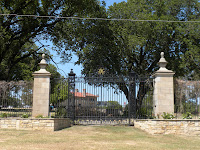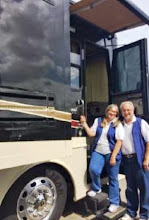The travel club's July camp out was at Lakeview Campground east of Ponca City. Although the campground has potential, it is still under construction and not yet ready for guests. We were greeted with large gravel which looked like the riprap material used on the banks of lakes and rivers, which made it extremely difficult to navigate by foot. There once stood a frame farm house on the site and the original tornado shelter is the only structure remaining. Debris piles are scattered throughout the future park, but the utilities were up and running and we enjoyed 50 amp electrical service and onsite water and sewer. Because of the extreme summer temperatures (100-109 degrees), the 50 amp service was needed to power two RV air-conditioners.

In spite of the less than acceptable campsite, the weekend activities were truly enjoyable. Floyd and Joyce Cook served as wagon masters for the camp out and did an excellent job in scheduling the tour sites.
It's amazing how we take for granted the rich history that Oklahoma has to offer. Crystal Bickford, of the Ponca City Chamber of Commerce, met with us for coffee and donuts early Friday morning and apprised our group of the colorful Ponca City history and landmarks situated within the community.

Considered the "Father of Ponca City," E.W. Marland, also a former Oklahoma Congressman, the tenth governor of Oklahoma, and multi-millionaire oilman, was responsible for securing the famous Pioneer Woman Statue. Marland considered the statue a gift to the people of Ponca City. The statue was dedicated in April 1930 and is inscribed with the following words: "In appreciation of the heroic character of the women who braved the dangers and endured the hardships incident to daily life of the pioneer and homesteader in this country.”

Marland invited 17 sculptors to submit designs in the form of small models, which were exhibited across the country and over 750,000 people cast votes in favor of their selection. Bryant Baker's vision was selected because it portrayed a woman of confidence, beauty and dignity. The following picture is a sampling of the models that were submitted but not chosen, and on display at the Marland Mansion:

It's important to understand who E.W. (Ernest Whitworth) Marland was in Oklahoma's history. He was born on May 8, 1874, and came to Oklahoma from Pennsylvania in December 1908, which was the year after Oklahoma became a state. He was educated in law, but gained an interest in the oil industry while working in a Pennsylvania law firm.

At the age of 33, Marland became a self-made millionaire in the oil business, but lost it during the panic of 1907. Broke and unemployed, Marland came to Oklahoma seeking oil drilling opportunities in the Ponca City area. He became acquainted with the Miller brothers of the famed 101 Ranch, which was famous for Wild West Shows and celebrities such as Tom Mix, Bill Picket, Pawnee Bill, and Buffalo Bill. Marland successfully drilled for oil on the Millers' ranch and once again achieved his millionaire status building a net worth of over $88 million dollars.


Marland Oil Company eventually merged with Continental Oil Company, which later became Conoco (now Conoco/Phillips).

Marland lost his company and fortune to J.P. Morgan during the stock market crash of 1929. In retaliation, he later ran for and was elected to the U.S. Congress where he sought legislation to limit hostile takeovers of corporate entities. After returning to Oklahoma, Marland ran for and was elected Governor. Marland died on October 3, 1941.
Our tour actually began with a visit to Marland's "Grand Home." The property is situated at 1000 East Grand Avenue in Ponca City, which Marland and his first wife, Mary Virginia, purchased in 1916. The 22-room home is of Italian Renaissance Revival styling and contains over 16,500 square feet.






The picture at the lower right depicts a display of D.A.R. (Daughters of the American Revolution) memorabilia. As most of you know, my lovely wife, Susan, is currently serving as vice-regent of the Oklahoma City Chapter of D.A.R. Obviously, this room was very important to her.
The Grand Home is said to contain the first indoor swimming pool in Oklahoma. The following picture is obscure because of the glare through the glass window, but reflects the grandeur of Marland's lifestyle in the early 1900s:

The basement of the Grand Home contains numerous artifacts taken from the 101 Ranch, which is a "must see" if you visit. Once you know the complete story and history of E.W. Marland, the 101 Ranch display in his basement makes perfect sense.
Side Note: On the way home, my navigator (Susan) had me turn the wrong way and we ended up on Oklahoma State Highway 156, which is now designated as 101 Ranch Memorial Road. As we came to the top of a hill at over 65 m.p.h., I caught a glimpse of a National Historic Landmark sign dated 1975 -- It was the remains of the historic 101 Ranch. The following picture is borrowed from the Chamber's website:

Now, before we leave the Grand Home and tour the Mansion, you need to know a few more facts about the history of the Marland family. E.W. and Mary Virginia were incapable of conceiving a child. But, they frequently enjoyed the company of Mary Virginia's nephew, George, and niece, Lyde (Lydie), during the summer months. When the children returned home to their family in Pennsylvania, Mary Virginia missed them dearly and felt the Grand Home was empty without their presence. With her husband's approval, Mary Virginia consulted her sister about adopting the children. Because the children's family was poor and the children would greatly benefit from the Marlands' wealth, Mary Virginia's sister and her husband approved the adoption. George was age 14, and Lydie was age 12 at the time of the adoption.

In the above photo, E.W. is seated in the center with Lydie at the lower left, George directly behind his sister, and Mary Virginia standing at the far right.
Mary Virginia took ill and died of pneumonia in 1926 at age 50. Before her death, the Marlands had traveled to Italy on many occasions and E.W. admired the architecture of Italian Renaissance villas. He dreamed of living in a palace and commenced construction of 43,561 square foot, 55-room mansion in 1925. But Mary Virginia died before the Mansion was completed. Two years after Mary Virginia's death, E.W. Marland took Lydie back to Pennsylvania, had the adoption annulled, and he and Lydie married on July 14, 1928. Lydie was age 28 at the time of their marriage.

The Grand Home is just that -- A "grand home" full of rich history. But it's certainly not as palatial as "The Marland Estate Mansion," otherwise known as "The Palace on the Prairie."















Construction of the mansion incorporated cutting edge technology for the time, including stainless steel counters and automatic dishwashers in the kitchen, multi-spray showers in the bathrooms, sauna, and central heat and air-conditioning.
The mansion was constructed at a cost of $2.5 million, which Marland paid for as it was built. E.W. and Lydie occupied the home from 1928-1931, and only for special occasions from 1931-1941. After losing his wealth during the depression, Marland could no longer afford to pay the staff or utilities required to run the mansion. Marland sold the property to the Carmelite Priests in 1941 for the price of $65,000, but retained the chaueffer's cottage and surrounding land which he left to Lydie in his will. The priests established a college of philosophy at the mansion and remained until 1948, when they sold the property to the Sisters of St. Felix for $50,000.
During the Marlands' occupancy, several statues of the family were erected upon the property, including one of Lydie.

Because of its "worldly appearance," the priests had it removed and placed in a crate next to the chaueffer's cottage. Outragged, Lydie instructed her gardner to destroy the statue and remove it from the premises. On his death bed, and after Lydie's death in 1987, the gardner revealed he had not complied with her instructions, but in fact broke the statue into several pieces and burried it. The statue was recovered and restored and is now on display in the foyer of the mansion.
Before her death, Lydie Marland persuaded the City of Ponca City to purchase the mansion and grounds from the Sisters of St. Felix for $1.4 million dollars, which was funded by a sales tax.
The Marland story is very intriquging and there is much more to be told. If you haven't visited the mansion and Grand Home in Ponca City, you're missing an amazing piece of Oklahoma's history.
The Modern Wagoneers not only toured the Marland properties, but also visited the Pioneer Woman Museum, The Conoco Museum, and the Poncan Theatre.



The Poncan Theatre, which opened in 1927, has 1200 seats, elaborate ceilings and ornamentation, and a balcony. The theatre is on the National Register of Historic Places and was restored to its original granduer in 1992. The travel club was fortunate to be in Ponca City on July 8th to experience "Elvis, The King Lives," starring Elvis impersonator, Kraig Parker.

Little did we know we had several "Elvis fans" in our midsts:


Wilma enjoys the show (above left), while Bill dances in the isle and Phyllis plans to steal a kiss from Elvis.
The members of our club always enjoy the tours of the places we visit, but two things are certain to happen whenever we get together -- we love to eat . . . .

and play games . . . .
 Some photos borrowed from The City of Ponca City and the Ponca City Chamber of Commerce.
Some photos borrowed from The City of Ponca City and the Ponca City Chamber of Commerce.


























































